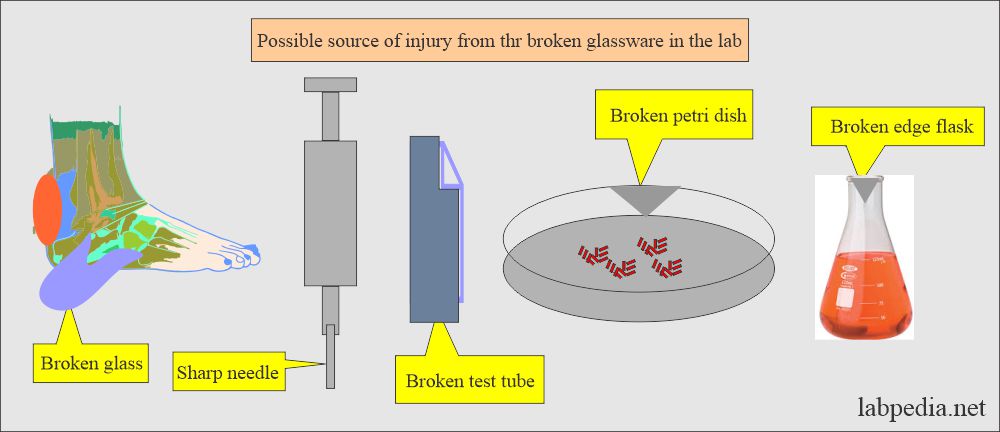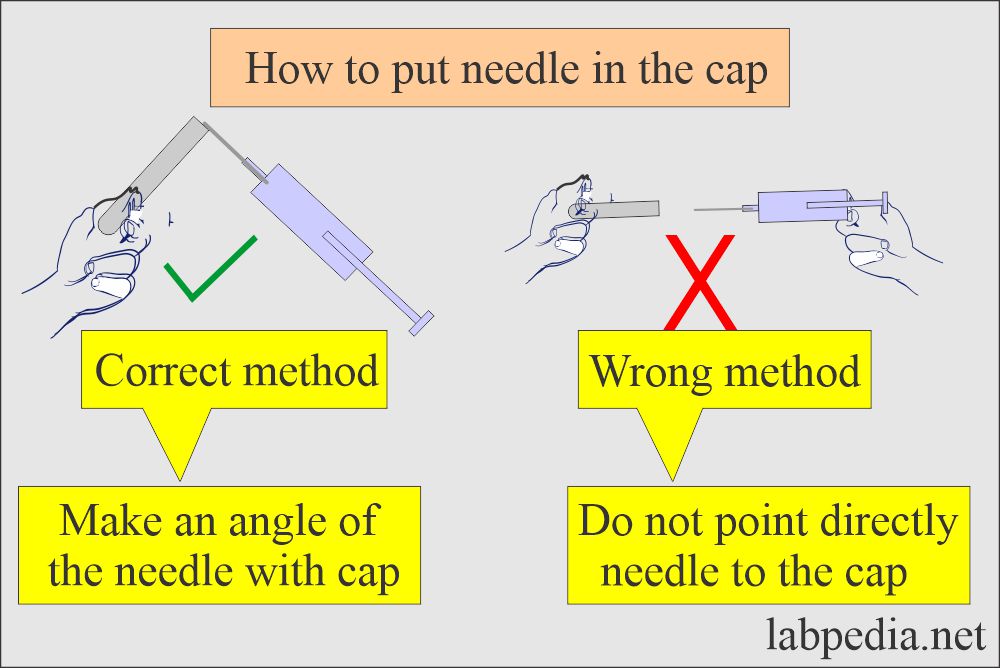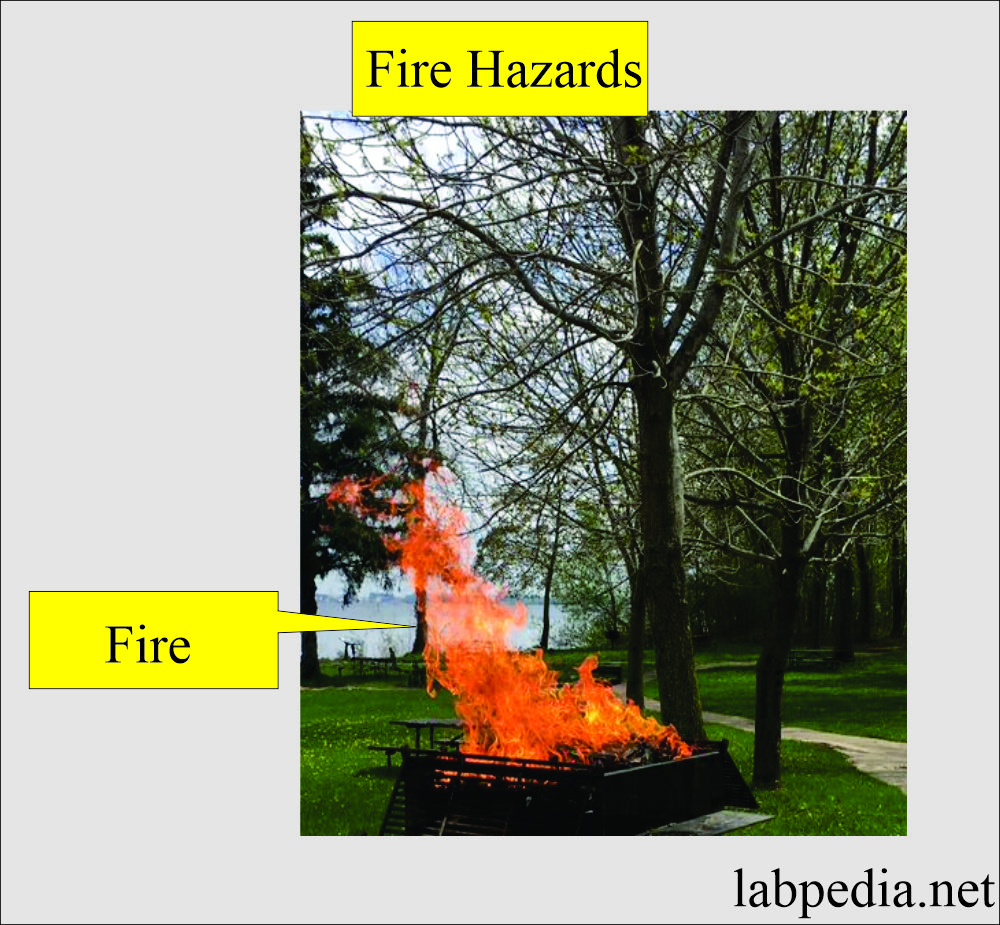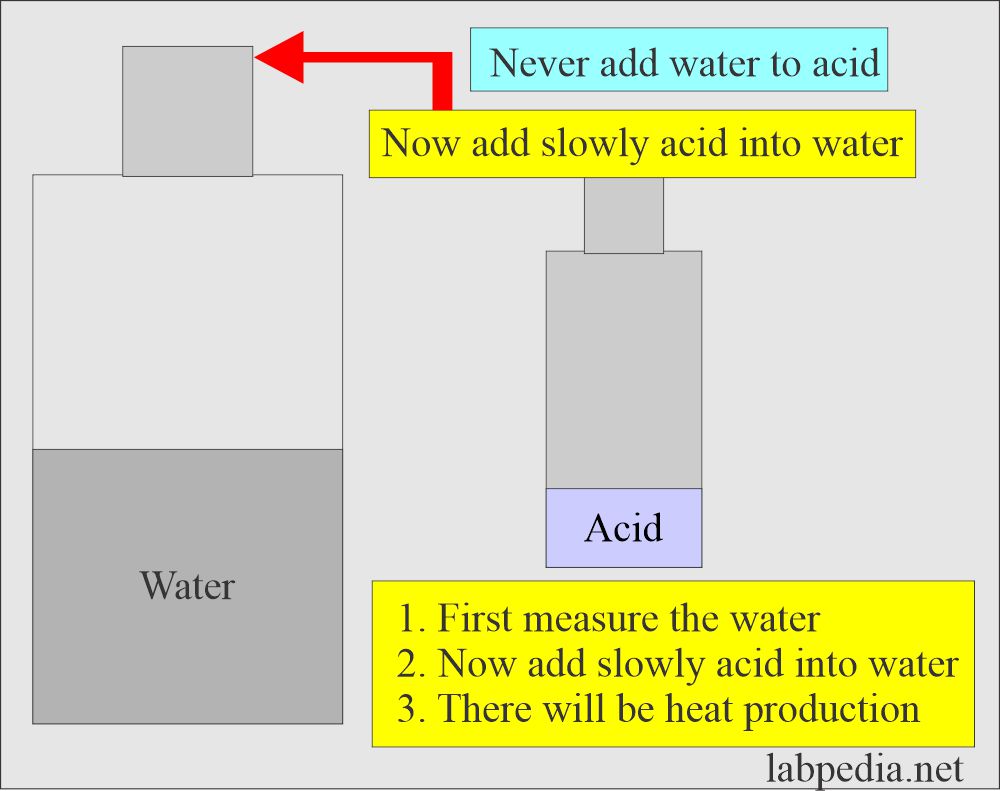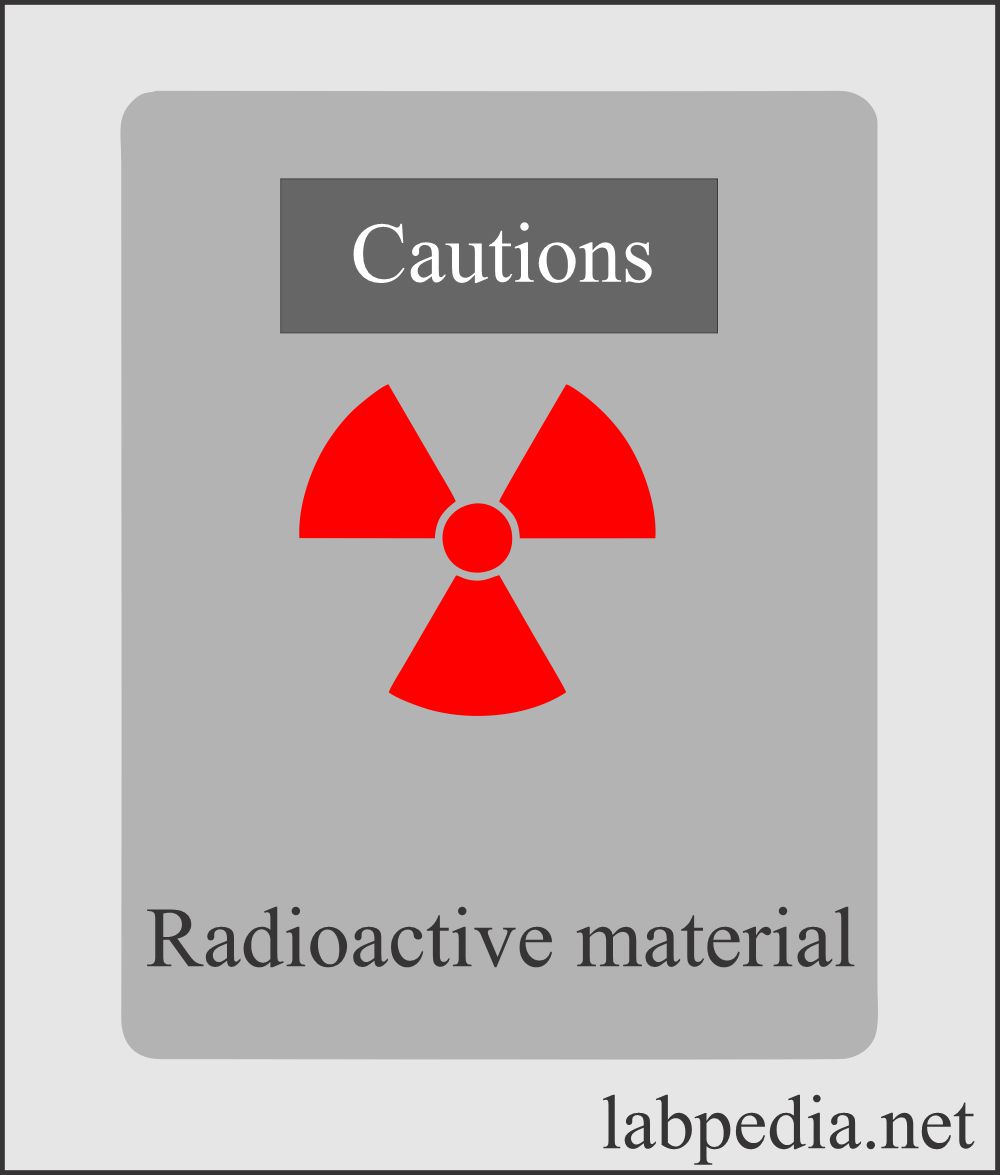Safety in the Clinical Laboratory
Safety in the Clinical Laboratory
- The clinical laboratory has various types of safety hazards. Some of these may be very dangerous and life-threatening.
- The laboratory workers must be aware of the various types of hazards and the possible precautions to avoid accidents.
- Eliminating hazards, establishing clean, safe work habits, taking proper precautions, and maintaining awareness of safety practices can reduce these dangers.
What are the main types of hazards in the laboratory?
| Possible type of agent | Source of the hazard | Injury or effect |
|
|
|
|
|
|
|
|
|
|
|
|
|
|
|
|
|
|
|
|
|
What are the Physical hazards?
- These are quite common, and they need to be avoided, e.g.,
- Running in the rooms and hallways.
- When the floor is wet, be careful.
- Take care while lifting heavy objects.
- Ladies should keep their long hair tight and on their backside.
- Avoid loose jewelry.
- Wear closed-toe shoes that provide maximum support.
- Try to keep the working area neat and clean.
- Also, keep the working area well-organized.
What are the sharp-edge instruments?
- Sharp edge instruments like a needles, broken glasses, and lancets give rise to biological hazards like:
- Give rise to blood-borne pathogens and diseases.
- These may give rise to bleeding.
- Dispose of all these sharp-edged articles in a safe place, like a metal container.
- Cut the needle of the syringe with the cutter.
- Also, crush the plastic syringes.
- Broken glassware:
- Beakers, test tubes, and flasks with broken edges are hazards in the lab.
- Remove all these broken edges of glassware.
- If you want to close the syringe needle, follow the following diagrammatic method.
What are the sources of Fire and explosives?
- In the laboratory, so many explosive and volatile chemicals are used in the routine.
- Flammable chemicals should be kept in the safety cabinet and explosion-proof refrigerators.
- Should keep the compressed gas cylinders away from the heat.
- The JCAHO gives fire protection guidelines.
- Whenever fire erupts, should take the following measures:
- Rescue anyone in immediate danger.
- Activate the institutional alarm.
- Close all the doors of the fire area.
- Try to extinguish the fire.
- Fire blankets should be available in the lab.
- May use Multiple-purpose fire extinguishers.
- One can follow the National Fire Protection Association (NFPA) guidelines.
| Type of fire | Extinguishing material |
|
|
|
|
|
|
|
|
What are the chemical hazards?
- These should be labeled as carcinogenic, poisonous, or corrosive.
- Strong acids and alkalies are the most common corrosive chemicals to which lab technicians are exposed.
- NFPA 704 gives the color coding for the materials. This color coding will help the firefighter.
- When mixing the acid and water:
- First, take the water and then slowly add the acid. Adding the acid to water will produce heat, which may burst out if you add water to the acid.
- In the case of chemical spills, the best option is to flush the area with water.
- Remove the contaminated clothes as soon as possible.
- OSHA gives a written chemical hygiene plan (CHP).
- It consists of the following:
- Appropriate work practice.
- Standard operating procedure.
- Personal protective equipment.
- Use of fume hoods and flammable safety cabinets.
- Employee training equipment.
- Medical consultation guidelines.
- Label hazardous chemicals.
What are the sources of Toxic fumes?
- There are solvents whose fumes (vapors) are toxic.
- Extracts with chlorinated hydrocarbons, chemicals that cause damage to the liver.
- Few solvents cause bone marrow depression with leucopenia, thrombocytopenia, and anemia.
- There are a few chemicals that are carcinogenic.
- Precautions:
- In the case of organic solvents, use a hood and work in a well-ventilated area.
- Avoid contamination of the skin because these can get absorbed slowly. Wash immediately with soap and water.
What are the sources of Electrical hazards?
- There are so many pieces of equipment working on electricity.
- Avoid wet hands when operating the equipment.
- Look after the damaged wires and avoid overloading the circuits.
- If any equipment becomes wet, immediately unplug the wires and let them dry before using it.
- Try to ground all the equipment.
- If accidents occur and someone has an electric shock, immediately shut off the electricity without touching the person or equipment.
- Close the circuit breaker.
- Move the equipment with some nonconductor objects like wood or glass.
What are the sources of Biological complications (Infections)?
- Laboratory staff is always exposed to sources of potentially pathogenic microorganisms.
- Hospitals are always filled with sick patients, some of whom have contagious diseases.
- Most of the samples, such as blood, body fluids, urine, CSF, and tissues, contain pathogenic organisms.
- The spread of infections may be by:
- Direct contact with the laboratory staff to the patient sample.
- By inhalation of the infected material, e.g., by droplet infection, or if you are centrifuging the tube without caping it.
- By ingestion of contaminated foods and water.
- Then, you may spread the infection to your colleagues.
- Personal handwashing and wearing personal protective clothes and pieces of equipment are important.
- Special precautions are needed while handling the sample of a patient with HBV, HIV, and HCV viruses.
- Wear gloves while collecting blood from the possible cause of HBV, HCV, or HIV.
- Wear a face mask if there is any possibility of splashing blood.
- Dispose of all the sharp needles and objects in the puncture-resistant containers.
- Follow the CDC universal precautions (UP).
- In 1996, the CDC combined the UP and Body surface isolation (BSI) and gave the guidelines:
- Advised to wash the hands after handling the blood or body fluids or secretions.
- Wash hands immediately after removing the gloves.
- Wear gloves when touching the blood, body fluids, secretions, excretions, and contaminated items.
- Wear gloves when touching mucous membranes or nonintact skin.
- Change the gloves on the same patient if a high concentration of pathogens is possible.
- Immediately remove the gloves and wash your hands before going to another patient.
- Waer the mask, eye protection, and face shield to protect the mucous membranes of the eye, nose, and mouth during the procedure where there is any danger of the splash or spray of blood, body fluids, excretions, and secretions.
- Wearing a gown protects the clothes and skin during the procedure.
- If the gown is soiled, remove it immediately and wash your hands to prevent others from spreading the infection.
- Clean the patient care equipment and sterilize it.
- Never recap the used needle; it is better to dispose of it. Or follow the directions given in the above diagram.
- Most important in the case of prick or bleeding:
- Don’t stop the blood immediately; the best is to bleed under the tap water as much as possible and then use disinfectants to stop the bleeding.
What are the sources of Carcinogens?
- The original list of OSHA published in 1974 pointed to 14 carcinogens. They revised the list in 1978.
OSHA list of carcinogens:
- Ethyleneimine
- 2-Acetylaminofluorene
- Benzidine
- Methyl chloromethyl ether
- Nitrobiphenyl.
- N-nitrosodimethylamine
- 4’4′- methylene bis ( 2-chloroaniline).
- Alpha-naphthylamine.
- Beta-naphthylamine.
- 3,3, Dichlorobenzidine.
- 4- Dmethylaminoazobenzene
- Benzidine is used to measure hemoglobin. Now, there are alternatives to noncarcinogens available, like ortho-substituted tetramethyl-benzidine for benzidine. O-toluidine and dianisidine are weak carcinogens used as chromogens in the enzymatic reaction in which H2O2 is produced with glucose oxidase and uricase.
What are the sources of Radioactive materials?
- This is needed when using radioactive material like radioisotopes.
- Mostly, the radioactivity in the laboratory is minimal dangerous.
- The best option is to wear a measuring device.
- Should avoid exposure to pregnant ladies because that will cause harm to the fetus.
- The ladies should avoid such areas of radiation.
Questions and answers:
Question 1: What is the recommendation of the OSHA for chemicals?
Question 2: Name most common physical hazard?


